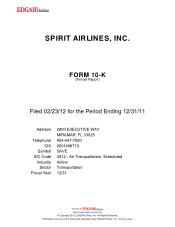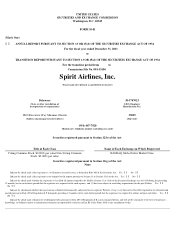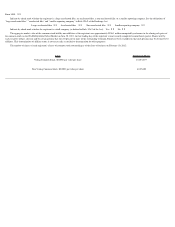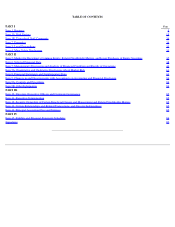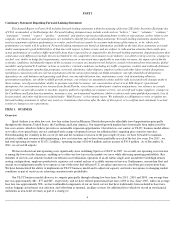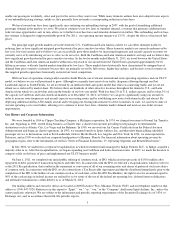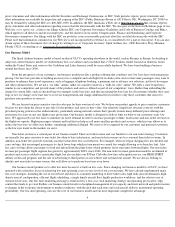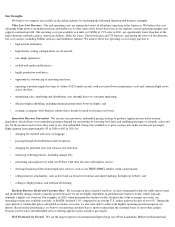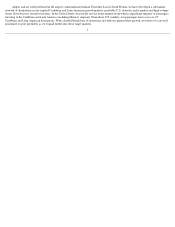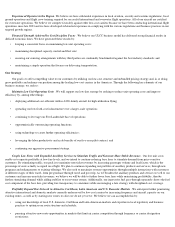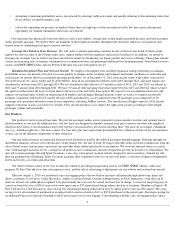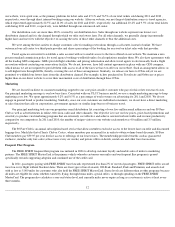Spirit Airlines 2011 Annual Report Download - page 5
Download and view the complete annual report
Please find page 5 of the 2011 Spirit Airlines annual report below. You can navigate through the pages in the report by either clicking on the pages listed below, or by using the keyword search tool below to find specific information within the annual report.
PART I
Cautionary Statement Regarding Forward-Looking Statements
This Annual Report on Form 10-K includes forward-looking statements within the meaning of Section 21E of the Securities Exchange Act
of 1934, as amended, or the Exchange Act. Forward-looking statements may include words such as “believe,” “may,” “estimate,” “continue,”
“anticipate,” “intend,” “expect,” “predict,” “potential” and similar expressions indicating future results or expectations, as they relate to our
company, our business and our management, are intended to identify forward-looking statements. Forward-looking statements should not be
read as a guarantee of future performance or results, and will not necessarily be accurate indications of the times at, or by, which such
performance or results will be achieved. Forward
-looking statements are based on information available at the time those statements are made
and/or management's good faith belief as of that time with respect to future events, and are subject to risks and uncertainties that could cause
actual performance or results to differ materially from those expressed in or suggested by the forward-
looking statements. Important factors that
could cause such differences include, but are not limited to: the competitive environment in our industry; our ability to keep cost low; changes in
our fuel cost; ability to hedge fuel requirements; restrictions on or increased taxes applicable to non-ticket revenues; the impact of worldwide
economic conditions, including the impact of the economic recession on customer travel behavior; actual or threatened terrorist attacks, global
instability and potential U.S. military actions or activities; external conditions, including air traffic congestion, weather and outbreak of disease;
restriction on third-party membership programs; air travel substitutes; labor disputes, employee strikes and other labor-related disruptions,
including in connection with our current negotiations with the union representing our flight attendants; aircraft-related fixed obligations;
dependence on cash balances and operating cash flows; our aircraft utilization rate; maintenance costs; lack of marketing alliances;
government regulation; our ability to fulfill growth strategy; our reliance on automated systems and the risks associated with changes made to
those systems; use of personal data; ability to generate non-ticket revenues; our concentration of services at FLL Airport; operational
disruptions; the concentration of our revenue from South Florida; our reliance on third-party vendors and partners; our reliance on a single
fuel provider; an aircraft accident or incident; negative publicity regarding our customer service; our aircraft and engine suppliers; changes in
the Caribbean and Latin America markets; insurance costs; environmental regulations; ability to attract and retain qualified personnel; loss of
key personnel; and other risk factors included under “Risk Factors” in this annual report. We undertake no obligation to revise or update any
forward
-looking statements to reflect any event or circumstance that arises after the date of this report, or to confirm such statements to actual
results or changes in our expectations.
ITEM 1. BUSINESS
Overview
Spirit Airlines is an ultra low-cost, low-fare airline based in Miramar, Florida that provides affordable travel opportunities principally
throughout the domestic United States, the Caribbean and Latin America. Our targeted growth markets have historically been underserved by
low-cost carriers, which we believe provides us sustainable expansion opportunities. Our ultra low-
cost carrier, or ULCC, business model allows
us to offer a low-priced basic service combined with a range of optional services for additional fees, targeting price-sensitive travelers.
Notwithstanding the volatility in the cost of jet fuel and the economic recession of the past couple of years, we have been able to maintain
relatively stable unit revenue while maintaining a low-cost structure, and we have been profitable in each of the last five years. For 2011 , we
had total operating revenues of $1,071.2 million , operating income of $144.4 million and net income of $76.4 million . As of December 31,
2011, we served 48 airports.
We have reduced our unit operating costs significantly since redefining Spirit as a ULCC in 2007. As a result, our operating cost structure
is among the lowest in the Americas, enabling us to offer very low fares in the markets we serve while delivering operating profitability. Key
elements of our low-cost structure include our efficient asset utilization, operation of an all Airbus single-aisle aircraft fleet with high-density
seating configurations, employee productivity, rigorous cost control and use of scalable outsourced services. Furthermore, our modern fleet and
aircraft seat configuration enable us to operate as one of the most fuel-efficient U.S. jet airline operators on a fuel burn per seat per hour basis.
We have demonstrated the ability to implement our ULCC business model and to adjust our capacity and routes in response to changing market
conditions as part of our focus on achieving consistent route profitability.
Our ULCC business model allows us to compete principally through offering low base fares. For 2011 , 2010 and 2009 , our average base
fare was approximately $81 , $77 and $85
, respectively, and we have offered promotional base fares of $9 or less. Since 2007, when our average
base fare was approximately $98 , we have unbundled components of our air travel service that have traditionally been included in base fares,
such as baggage and advance seat selection, and offer them as optional, ancillary services for additional fees (which we record in our financial
statements as non-ticket revenue) as part of a strategy to
4

